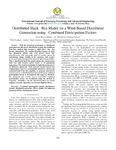Distributed Slack Bus Model for a Wind-Based Distributed Generation using Combined Participation Factors
Abstract
With the increased penetration of distributed generation into the power distribution system, the traditional load flow analysis that assumes a single slack bus has become impractical. The existing literature focuses on slack bus placement taking only real power losses into place.However with increasing need of reactive power in maintaining voltage stability at the consumer end; reactive power generation management cannot be ignored any further. Thus a distributed slack bus model taking into consideration both real and reactive power losses is of paramount importance. The wind based doubly fed induction generator is an attractive option for both real and reactive power loss compensation since it is economically attractive, can be grid connected and it has the capability to generate and absorb reactive power. A distributed slack bus model using combined participation factors is developed in this paper to distribute the slack(real and reactive power losses).The combined participation factors are formulated using the method of Lagrange multipliers and the distributed slack bus model employs a Genetic Algorithm of a Newton Raphson Solver

